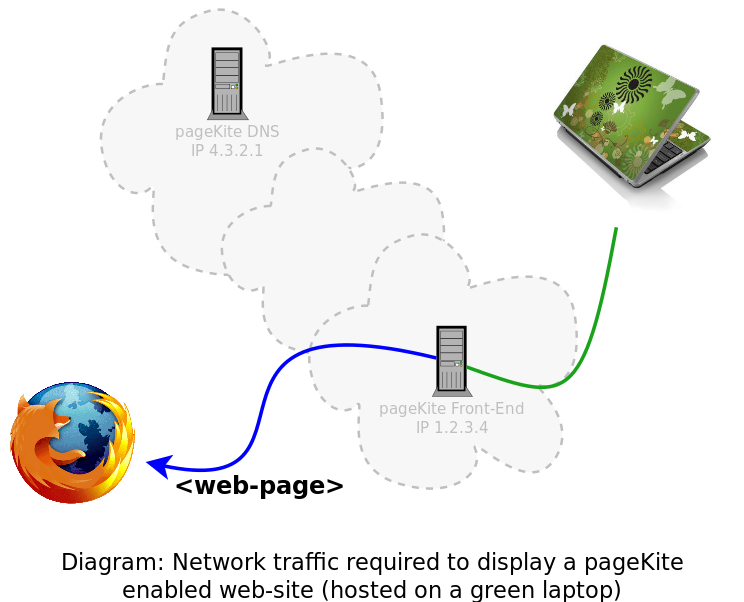PageKite: why Python?
Bjarni Rúnar Einarsson • PageKite.net
What is PageKite?
Enabling (web)servers everywhere
PageKite is a tool for enabling (web)servers anywhere:
- PCs, laptops, mobile phones, embedded hardware ...
Problems to solve:
- Most devices don't have visible IP addresses
- Most devices are behind firewalls
- Many devices move around a lot
- Many "networks" only have one public IP for many computers
IPv6?
Diagram: A PageKite-enabled website






|
pagekite.py + pagekite.net
Introducing pagekite.py
pagekite.py implements a tunneled reverse proxy.
- General features ...
- Open source / free software - AGPL license
- Designed to be easy to use and deploy
- Is an HTTP and HTTPS reverse proxy (and SSH!)
- Protocol-agnostic tunneling:
- Tunnels through firewalls and NAT (outgoing TCP)
- Uses adaptive compression (zlib)
- Implements both ends: front & back
- Built-in HTTP server for diagnostics
A trivial example
This is one way to make a web server on localhost (ports 8000 and 8443) visible as http://bar.foo.net/, ...
foo.net $ sudo pagekite.py --runas=nobody \ --isfrontend --ports=80,443 \ --domain=raw,http,https:*.foo.net:s3cr37
laptop $ pagekite.py \ --frontend=foo.net:443 \ --backend=http:bar.foo.net:localhost:8000:s3cr37 \ --backend=https:bar.foo.net:localhost:8443:s3cr37
Introducing pagekite.net
pagekite.net is a front-end service provider, a "FOSS start-up"
- Goals
- Fund pagekite.py and related development
- Make the tech. available to non-technical users
- Features
(italics = works in progress)
- Geographically distributed, managed front-ends
- Privacy friendly: minimal records, anonymized logs, simple ToS, IMMI
- Use name.pagekite.me or your own domain
- Unlimited subdomains & active connections
- Free SSL for everyone! - wildcard on *.pagekite.me
- We charge for bandwidth ...so no ads!
Use-cases I've seen...
Some of the use-cases I have seen so far:
- A web-server on my Android phone, just for fun.
- 4 Linux VMs on a gaming rig at home: all visible, my own cloud.
- My web guy demoing designs directly from his laptop
- Teachers publishing class material off recycled hardware
- Arduino hackers sending data to Pachube.com
- Pagekite+SSH for remote administration of embedded HW in factories
Basically any time a router or firewall is in the way.
... so why Python?
Choosing a programming language
Language requirements:
- Must not suck!
- Same language for program and service
- Ease of program deployment
- Good support for the WWW
Things we don't care about (yet):
- Raw speed
- Footprint (RAM, disk)
So how is it doing? - good
The good:
- I can use Python 2.2 as a baseline
- Installation is indeed easy
- Exceptions let me adapt to my environment
- Python comes with Linux, Mac OS X!
- Py2exe helps with Windows
- Django is awesome!
So how is it doing? - bad
The bad:
- I use Python 2.2 as a baseline.
- Multiple almost-compatible SSL libraries, limited APIs
- Adding a GUI will fragment the code
- Django assumes an SQL backend (I use Redis)
- Memory bloat ...
So how is it doing? - ugly
Things moved around during Python's development ...
try: from urlparse import parse_qs, urlparse except ImportError, e: from cgi import parse_qs from urlparse import urlparse
So how is it doing? - ugly
Argh, different OSes throw different errors!
HARMLESS_ERRNOS = (errno.EINTR, errno.EAGAIN, errno.ENOMEM, errno.EBUSY,
errno.EDEADLK, errno.EWOULDBLOCK, errno.ENOBUFS,
errno.EALREADY)
...
try:
sent_bytes = self.fd.send(sending)
except IOError, err:
if err.errno not in self.HARMLESS_ERRNOS:
self.LogError('Error sending: %s' % err)
return False
...
So how is it doing? - ugly
The SSL APIs are a bit inconsistent, so ...
def Shutdown(self, direction):
try:
if self.fd:
if 'sock_shutdown' in dir(self.fd):
# This is a pyOpenSSL socket, which has incompatible shutdown.
if direction == socket.SHUT_RD: self.fd.shutdown()
else:
self.fd.shutdown(direction)
except Exception, e:
self.LogDebug('Shutdown (%s/%s) error: %s' % (direction, self.fd, e))
Thank you!
Questions?
Links:
- Code, company: PageKite.net
- Slides: pagekite.net/slides/rpug2011/
- Github: github.com/pagekite/PyPagekite
Bonus FAQ slide!
- But my $device isn't on-line all the time!
- Do all websites need to be highly available?
- Isn't proxying everything really slow?
- Reduced RTT and compression make up for the detour
- Isn't pagekite.net a centralized service too?
- Pagekite is a router, not a data store
- It's FOSS, you have choice & can run your own
- What about backups?
- Yes, you still need backups. :-)